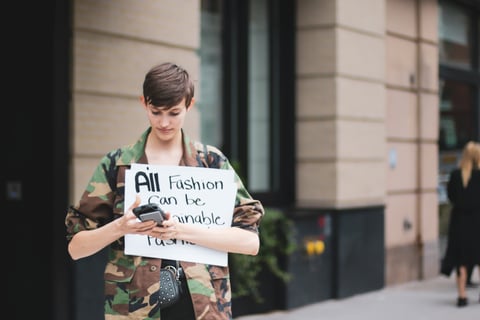 Photo: Ron Lach
Photo: Ron Lach
Making the switch to sustainable clothes? When your wardrobe has a gap, replacing items with eco options means fewer chemicals and resources were used—a benefit to your garment, the growers and manufacturers, and the planet. In many cases, it also means better treatment for garment workers, too.
There’s good reason to extend the life of all clothes—sustainable or not. The longer we can keep items in circulation, it means they’re not going to landfills or overcrowding secondhand stores. Whether your wardrobe is a capsule collection or it’s a bit Carrie Bradshaw, it’s worth keeping the items in their best shape. And how clothes are washed can vary greatly by material.
See also: 5 vegan alternatives for silk if you love “silky” soft fabrics
Eco-friendly laundry detergents
If your clothes are doing good for the planet, your laundry detergent should be, too, right? Eco-friendly laundry detergents are gentler on your clothes, often are safer for your health, and they’re much gentler on the environment.
A truly eco-friendly laundry detergent will be free from bleach or chlorine and other chemical brighteners. They should also be free from phosphates—a detergent won’t be biodegradable if it contains phosphates. And if it’s not biodegradable, it’s not eco-friendly.
Anything promising scents that don’t exist in nature—”fresh” as good as it sounds, isn’t a real scent, for example—is likely artificial. These artificial fragrances contain hundreds or thousands of chemicals, some of which have been linked to immunotoxicity, according to the Environmental Working Group’s Skin Deep database.
 Photo: The Laundress
Photo: The Laundress
Detergents wind up in waterways as most water treatment plants can’t fully filter them out. The cleaner your detergent is from the start, the lower the risk to marine animals.
Most detergents today are concentrated, which reduces the environmental impact of transport. Powders can be even better.
Looking for a sustainable laundry detergent with an elevated fragrance? Check out this list of eco laundry detergents with luxury fragrances.
Washing instructions may recommend water temperatures, but the most sustainable option is cold as it reduces energy use. Even mainstream detergent brand Tide backed this switch with a recent campaign. While Tide’s laundry detergent is not a sustainable option, its support for cold water washing is founded. Most materials will do better in cold than hot despite what the label says. And cold water will maintain the color of fabrics longer, too.
How often should you wash clothes?
Call it sustainability or call it Covid casual, but washing clothes after a single wear isn’t necessary for some materials. The more you can extend an item of clothing between washes, the fewer resources you use. And you may help keep the clothes brighter and in better shape with fewer washes.
See also: A Guide to Sustainable Fabrics
 Photo: Karolina Grabowska
Photo: Karolina Grabowska
For your undies, socks, and your sweat-drenched workout wear, give those a wash after a single wear. But for everything else, there’s some wiggle room. For tees and tops, an item can go 1-2 wears depending on activity and length of wear. Jeans can go three - four wears without a wash, sometimes more. Same for sweaters, sweatshirts, and sweatpants, depending on activity.
For other items, it’s okay to use the sniff test—yes, the sniff test. A pair of work pants (the kind you wear to an office, not the sweats you wear at home), can go several wears depending on the material. Same for oxfords. Sometimes a little shower steam can refresh a shirt or pants between washes, too.
Sustainable materials
There’s an increasing number of sustainable textiles and materials on the market likely to be in your eco clothes or bedding. Some wash similar to their conventional counterparts but be sure to check the labels or brand website for the best washing instructions for your items. But as a general rule, these are the best washing practices for these materials.
Organic Cotton and Denim
The most common natural fiber, you’ve likely been wearing and washing cotton for years—and even some unsuspecting organic cotton, too. Cotton can withstand heat and is generally durable. Colors can run, so new items should be washed separately to avoid damaging other clothes.
Cotton tees, pants, shirts, and dresses should be washed in warm or cold water to prevent shrinkage and stretching. But for undies, PJs, towels, and bed linens, hot water helps to remove bacteria and body oils.
If you line dry clothes, only put your white cotton garments out as the sun can bleach away colors and cause fading.
Bamboo
Bamboo is appearing in more textiles these days including dresses, tops, and bedding. Growing bamboo uses 500 times less water than cotton, and can produce 52 percent fewer emissions. But a word of caution: not all bamboo is sustainable. That’s because the refining process can be chemically intensive, turning the material into rayon, which produces more chemicals and makes the end product not biodegradable.
 Photo: ettitude
Photo: ettitude
But when you do have truly sustainable bamboo, you’ll want to take care of it. According to bamboo bedding brand Ettitude, bamboo does best in cold water on gentle cycle. It recommends washing bamboo separately from other items, especially towels, as they can cause lint build-up. The brand says to use a biodegradable liquid soap or fully dissolve powder in water before adding.
Because bamboo is naturally soft, you don’t need to use a fabric softener. Bamboo does well line drying. If that’s not an option, tumble on low.
Viscose
Viscose is typically derived from wood pulp, and will eventually biodegrade. It’s considered a synthetic fabric, but a number of sustainable designers are using it, verifying sources and quality. The material is highly absorbent, and can therefore be delicate when wet, so hand washing is recommended for viscose.
Use cold or lukewarm water and carefully rub out stains or odors with detergent. For best results, wash inside out. If using a machine is the only option, use a wash bag to prevent damage. Do not machine dry. Air or flat dry for best results.
Tencel
Like viscose, Tencel, or lyocell, is typically derived from wood pulp to create a rayon material. It’s soft, breathable, and flattering due to its “drape” effect. A wrinkle-resistant material, Tencel is seeing more use across sustainable fashion. Keep your Tencel in its best shape by hand washing delicate items similar to viscose. For bedding, use the cold or warm settings on gentle.
 Photo: FabricSight
Photo: FabricSight
Your Tencel garments may shrink with the first washing—this is normal. Some can lose up to three percent of mass, so if you like looser garments, size up when purchasing.
Line dry if possible or use the gentle setting. Some Tencel is recommended as dry clean only.
Nylon
Traditional nylon is not a sustainable fabric as it’s a byproduct of petroleum. But labels like Prada, Reformation, and Adidas are using upcycled plastic to create nylon materials that perform just like traditional nylon. The most common is Econyl, which is made from pre-consumer scraps and post-consumer waste. Parley for the Oceans, for example, uses ocean-bound plastic to create materials used by Adidas. Econyl is Okeo-Tex certified, meaning it’s free from harmful chemicals.
One of the main benefits of nylon is that it is a durable fabric, resistant to wear and tear. But that doesn’t mean nylon can handle the brutal battleground of your washing machine.
The more nylon is washed and dried, the more the material will pill and fade. Nylon does best hand-washed in cold water. Be sure to avoid bleach with nylon. Ideally hang or flat dry your nylon. If you need to use a dryer, opt for the lowest temperature setting.
Linen
Linen is a soft, breathable material that makes for gorgeous, flowy clothes, and the comfiest of bed linens. From the same plant as flax seeds, it is strong, naturally moth resistant, and can withstand high temperatures. It’s been worn for ages, and if untreated, is fully biodegradable.
 Photo: Eileen Fisher
Photo: Eileen Fisher





